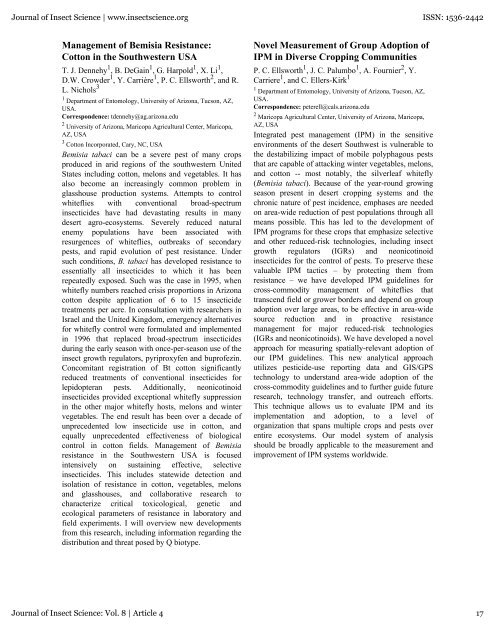Fourth International Bemisia Workshop International Whitefly ...
Fourth International Bemisia Workshop International Whitefly ...
Fourth International Bemisia Workshop International Whitefly ...
Create successful ePaper yourself
Turn your PDF publications into a flip-book with our unique Google optimized e-Paper software.
Journal of Insect Science | www.insectscience.org ISSN: 1536-2442<br />
Management of <strong>Bemisia</strong> Resistance:<br />
Cotton in the Southwestern USA<br />
T. J. Dennehy 1 , B. DeGain 1 , G. Harpold 1 , X. Li 1 ,<br />
D.W. Crowder 1 , Y. Carrière 1 , P. C. Ellsworth 2 , and R.<br />
L. Nichols 3<br />
1 Department of Entomology, University of Arizona, Tucson, AZ,<br />
USA.<br />
Correspondence: tdennehy@ag.arizona.edu<br />
2 University of Arizona, Maricopa Agricultural Center, Maricopa,<br />
AZ, USA<br />
3 Cotton Incorporated, Cary, NC, USA<br />
<strong>Bemisia</strong> tabaci can be a severe pest of many crops<br />
produced in arid regions of the southwestern United<br />
States including cotton, melons and vegetables. It has<br />
also become an increasingly common problem in<br />
glasshouse production systems. Attempts to control<br />
whiteflies with conventional broad-spectrum<br />
insecticides have had devastating results in many<br />
desert agro-ecosystems. Severely reduced natural<br />
enemy populations have been associated with<br />
resurgences of whiteflies, outbreaks of secondary<br />
pests, and rapid evolution of pest resistance. Under<br />
such conditions, B. tabaci has developed resistance to<br />
essentially all insecticides to which it has been<br />
repeatedly exposed. Such was the case in 1995, when<br />
whitefly numbers reached crisis proportions in Arizona<br />
cotton despite application of 6 to 15 insecticide<br />
treatments per acre. In consultation with researchers in<br />
Israel and the United Kingdom, emergency alternatives<br />
for whitefly control were formulated and implemented<br />
in 1996 that replaced broad-spectrum insecticides<br />
during the early season with once-per-season use of the<br />
insect growth regulators, pyriproxyfen and buprofezin.<br />
Concomitant registration of Bt cotton significantly<br />
reduced treatments of conventional insecticides for<br />
lepidopteran pests. Additionally, neonicotinoid<br />
insecticides provided exceptional whitefly suppression<br />
in the other major whitefly hosts, melons and winter<br />
vegetables. The end result has been over a decade of<br />
unprecedented low insecticide use in cotton, and<br />
equally unprecedented effectiveness of biological<br />
control in cotton fields. Management of <strong>Bemisia</strong><br />
resistance in the Southwestern USA is focused<br />
intensively on sustaining effective, selective<br />
insecticides. This includes statewide detection and<br />
isolation of resistance in cotton, vegetables, melons<br />
and glasshouses, and collaborative research to<br />
characterize critical toxicological, genetic and<br />
ecological parameters of resistance in laboratory and<br />
field experiments. I will overview new developments<br />
from this research, including information regarding the<br />
distribution and threat posed by Q biotype.<br />
Novel Measurement of Group Adoption of<br />
IPM in Diverse Cropping Communities<br />
P. C. Ellsworth 1 , J. C. Palumbo 1 , A. Fournier 2 , Y.<br />
Carriere 1 , and C. Ellers-Kirk 1<br />
1 Department of Entomology, University of Arizona, Tucson, AZ,<br />
USA.<br />
Correspondence: peterell@cals.arizona.edu<br />
2 Maricopa Agricultural Center, University of Arizona, Maricopa,<br />
AZ, USA<br />
Integrated pest management (IPM) in the sensitive<br />
environments of the desert Southwest is vulnerable to<br />
the destabilizing impact of mobile polyphagous pests<br />
that are capable of attacking winter vegetables, melons,<br />
and cotton -- most notably, the silverleaf whitefly<br />
(<strong>Bemisia</strong> tabaci). Because of the year-round growing<br />
season present in desert cropping systems and the<br />
chronic nature of pest incidence, emphases are needed<br />
on area-wide reduction of pest populations through all<br />
means possible. This has led to the development of<br />
IPM programs for these crops that emphasize selective<br />
and other reduced-risk technologies, including insect<br />
growth regulators (IGRs) and neonicotinoid<br />
insecticides for the control of pests. To preserve these<br />
valuable IPM tactics – by protecting them from<br />
resistance – we have developed IPM guidelines for<br />
cross-commodity management of whiteflies that<br />
transcend field or grower borders and depend on group<br />
adoption over large areas, to be effective in area-wide<br />
source reduction and in proactive resistance<br />
management for major reduced-risk technologies<br />
(IGRs and neonicotinoids). We have developed a novel<br />
approach for measuring spatially-relevant adoption of<br />
our IPM guidelines. This new analytical approach<br />
utilizes pesticide-use reporting data and GIS/GPS<br />
technology to understand area-wide adoption of the<br />
cross-commodity guidelines and to further guide future<br />
research, technology transfer, and outreach efforts.<br />
This technique allows us to evaluate IPM and its<br />
implementation and adoption, to a level of<br />
organization that spans multiple crops and pests over<br />
entire ecosystems. Our model system of analysis<br />
should be broadly applicable to the measurement and<br />
improvement of IPM systems worldwide.<br />
Journal of Insect Science: Vol. 8 | Article 4 17
















